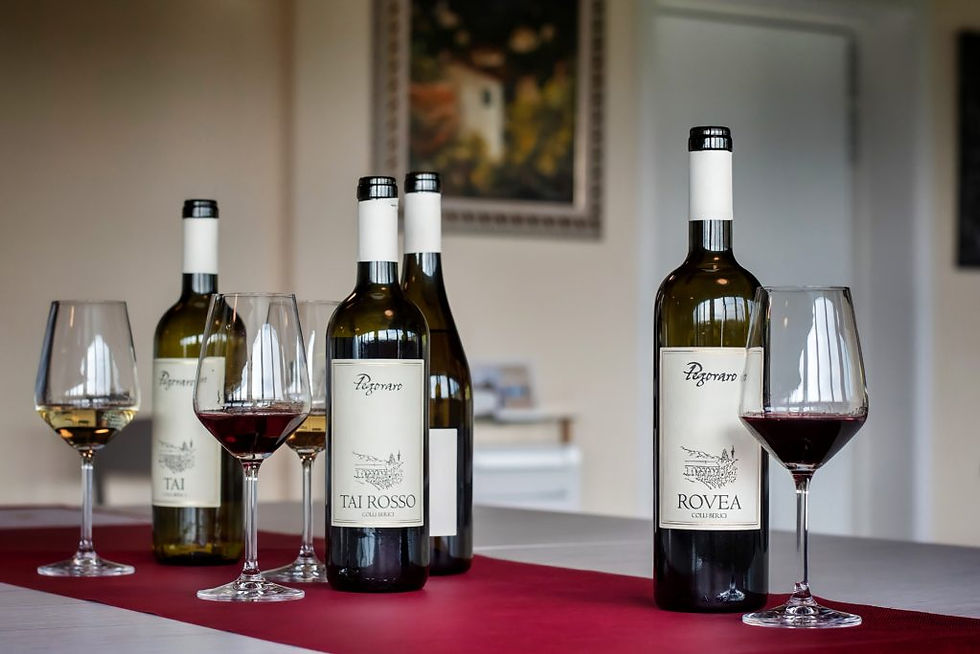The Berici Hills south of Vicenza in the Veneto are a place of quiet peace and tranquillity, far away from hustle and bustle. But even here, in this green haven, you can find yourself sucked down a wormhole into the depths of history as Vinnie and I found out when we visited Cantina Pegoraro. The oldest part of the beautiful buildings dates back to the 13th century and was originally a convent. The magnificent loggia that fronts it was added in the 15th century but even that did not seize my attention - what grabbed me was when Enrico, who was showing us round, casually remarked that it was then taken by Napoleon.
We mostly remember the French Revolution of 1789 for the mass executions of the Reign of Terror. But one of the targets of the revolutionaries was the Catholic church and the huge wealth it had accumulated. In 1796 Napoleon invaded and annexed northern Italy and, as part of France, the same policies of sequestration of property and suppression were pursued. Thus the convent ceased to be a religious building and it ended up as the property of the city of Vicenza.

Dragging myself with blinking eyes back into the bright light of the 21st century I focussed on the reason for our visit. The family was first associated with the property in 1950. In common with many small enterprises in those days, they simply sold on the grapes that they grew but in 1998 they produced their own wine commercially and in 2006 built the magnificent modern cantina that is the centre of their production today. Currently, they have 8 hectares of vineyards from which they produce around 50,000 bottles of wine per year.

The Berici Hills have their very own DOC but the rules that govern it allow for much greater variation than is usual. However, the principal variety is a local one called Tai and this is the one that is the focus of Cantina Pegoraro’s production. Part of the new winery building houses the shop and above that is a tasting room. With its traditionally beamed ceiling, it gives a panoramic view over the vineyards that sit on the slopes of the hills below the trees that cover the higher ground. The soil here is mainly limestone and clay and the vines growing here are up to 60 years old.
So it was in these delightful surroundings that we sampled the wines. We started with a 2020 Tai Bianco. This is 95% Tai with the balance made up of Sauvignon. After fermentation in stainless steel the wine matures on the lees until the end of December when it is bottled. The colour is a delicate pale gold with the scent of elderflower and passion fruit and on the palate there is a hint of mild citrus with a pleasant acidity and slight taste of almond. I would enjoy this with the subtle flavours of grilled plaice.

Moving on to the Tai Rosso, this is a grape that is genetically identical to Grenache but it has developed its own identity in the Berici Hills over the centuries. The story of the Pegoraro Tai Rosso starts in the oldest vineyards on the estate with a manual harvest in September. Fermentation takes about 10 days with a manual ‘punching down’ of the cap of skins 3 times a day to ensure that all the goodness is extracted from the skins. The wine then matures in steel tanks for a few months before bottling. We tasted the 2020 which has a lovely ruby colour with a singularly delightful bouquet of raspberries and what I can only describe as autumn bonfires which brought back wonderful memories of my childhood. This is a grape that does not produce much in the way of tannins but the wine has a good acidity with a flavour of plums on the palate. This would go well with pasta dishes and also salumi.

We finished our exploration of Tai Rosso with a wine called Rovea, in this case from 2018. Again 100% Tai Rosso, the grapes for this wine come from a part of the vineyard with rich volcanic soil. After a slightly later harvest in October there follows a long fermentation on the skins that extracts the maximum flavour. The wine then matures for 12 months in barriques before being bottled. The result has a deep ruby colour with a bouquet of vanilla and red fruit. On the palate it is full and rich whilst dry at the same time. There are tannins here from the wood but they are soft and gentle. This is a beautifully smooth wine that would pair well with roast beef.
This is a winery in an idyllic setting with the soft green hills providing the perfect rural backdrop, With an imposing historic loggia to the old building, a warm welcome from the family, and lovely wines from native grapes, why would you not want to visit?
Useful links:

コメント